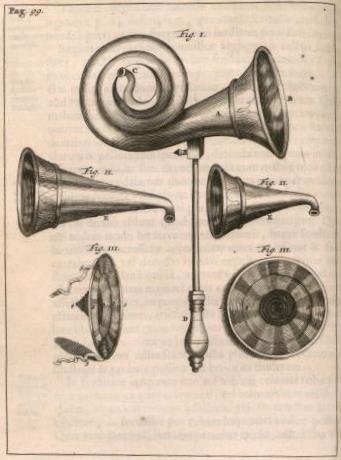
We might take it for granted that our hearing aids are hardly noticeable, can be managed with our smart phones, and can differentiate between speech and background noise. What we may not realize, however, is that those functions are the results of 400 years of research, design, and improvement.
Even as early as 5 years ago, hearing aids could not produce the clarity of sound produced at present. To understand why, let’s track the history of hearing aids—beginning today and going backwards—to see how hearing aids would have treated your hearing loss in four different years: 2016, 1985, 1940, and 1650.
2016 – Modern Day Digital Hearing Aids
It’s 2016 and you’re looking to address your hearing loss. You open up a web browser, search for a local hearing care professional, fill out a quick form, and book an appointment.
At your hearing test, your hearing is tested using advanced computer technology that accurately measures your hearing. Then, with the assistance of your hearing care consultant, you pick out a hearing aid that accommodates your requirements from an extensive selection of models.
Then, your hearing expert programs your new hearing aids to intensify only the sounds and frequencies you have difficulty hearing, producing crystal clear sound without distortion.
If you were to tell anyone in the 1980’s that this would be the process, they wouldn’t have believed it was possible.
So what did make it possible? In short, digital technology.
For most of their history, there was no way for hearing aids to differentiate between different sound frequencies. Hearing aids would intensify all incoming sound, including background noise, generating distorted sound.
The digital revolution cleared up that issue. With digital technology, all information can be altered, saved, and manipulated as combinations of 0’s and 1’s. Digital technology permitted hearing aids to transform sound frequencies into digital information, which could then be classified according to which sounds should be amplified (speech) and which should be suppressed (background noise).
The first all-digital hearing aid was produced in 1995, and since that time the technology has improved tremendously, eventually to incorporate wireless capability.
1985 – Transistor Hearing Aids
Now it’s 1985 and you’re planning to treat your hearing loss. You can forget browsing for a local hearing care provider on the internet because the first commercial internet service provider won’t be founded until 1989.
You’d have to use the phone book, depend on referrals, or drive around the neighborhood to find a hearing care practice.
After scheduling an appointment and having your hearing screened, your options for hearing aids are quite restricted. With no microprocessor and digital technology, hearing aids were designed with a series of transistors. This adds size and higher power requirements, resulting in larger batteries and massive hearing aids.
Also, without the advantage of digital technology, the hearing aid cannot distinguish between different frequencies of sound. Hearing aids receive inbound sound and the transistors behave as basic amplifiers, amplifying all sound. So if you’re in a loud room, speech recognition will be just about impossible.
1940 – Vacuum Tube Hearing Aids
It’s 1940 and you’re contemplating buying a hearing aid. Transistors haven’t been applied to hearing aids yet, so your choices are restricted to vacuum tube hearing aids.
Vacuum tubes utilize more power than transistors, so the hearing aids require larger batteries, making the hearing aids big, heavy, and cumbersome.
And once again, without digital technology, the hearing aids can only act as basic amplification devices, making all incoming sound louder. The hearing aids cannot enhance speech and can’t remove background noise.
1650 – Ear Trumpets
Let’s go all the way back to 1650. There’s no digital technology, no transistors, and no vacuum tubes. As a result, there is no way to transform sound into electrical currents that can be amplified.
With electrical amplification out of the question, your only possibility is mechanical amplification by focusing and compressing sound into the ear canal, such as what takes place when you cup your hands around your ears.
By 1650, products were developed that concentrated inbound sound into the ears, and these contraptions were called ear trumpets. They were prominent gadgets with a conical end that collected sound and a narrow end that concentrated the sound into the ear.
This would be the only technology readily available to individuals with hearing loss for the next 250 plus years.
Let’s return to 2016. Throughout more than 400 years of history, hearing aids have progressed from mechanical amplification devices to electrical amplification devices, from vacuum-tube-based to digital-based. They’ve come to be significantly smaller, lighter, and more efficient and affordable.
They’ve also become much better at differentiating among various types of sound, and in amplifying only certain kinds of sound (such as amplifying speech while repressing background noise).
Each generation of hearing aid has made a major enhancement over the previous generation. The question is, what’s the next great benchmark in the history of hearing aids?
Will we soon be able to improve natural human hearing, rather than merely restore it?
